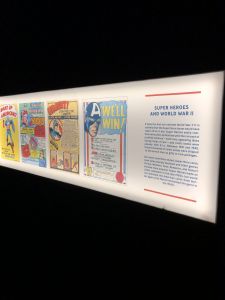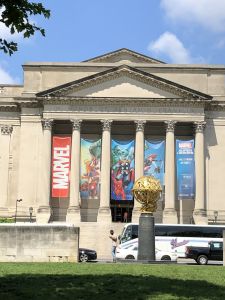“What makes comic books so unique in their time is they found a way to relate to people on different levels,” Ty Shawn Hopkins, sophomore physical therapy major Misercordia University, said. “Captain America during the world war made people feel patriotic and happy, and I think a lot of comic books through time have found a way to unite people.”
Back in the early 1800s comics were originally printed in newspapers and periodicals and contained sarcastic and comedic political stories. The content in comics began to evolve with the appearance of original cartoon characters and more developed stories. In 1897 the first “comic book,” created by Richard F. Outcault and titled “The Yellow Kid in McFadden Flats,” featured a collection of the most well known comic strip characters and was printed in black and white.
In 1938 the golden age of comics had begun. With the release of Action Comic’s #1, the first appearance of Superman, a national craze for costumed crime fighters had started. Comic books had reached their peak popularity in the 1940s as World War II was taking place. Heroes such as Batman, Superman and Captain America were selling millions of copies per month but once World War II ended superhero comic book sales dropped dramatically. In the 1950s comic book writers began releasing comic genres that would appeal to larger audiences including westerns, romances, crime stories and horror. Following the release of these more graphic comics, moral panic sparked and almost ruined the comic book industry. Comics were blamed for the inappropriate behavior of children.

In 1954 the psychiatrist Fredric Wertham published his best selling book, “Seduction of the innocent.” The book presented his theory on how comic books were a leading cause of corruption to America’s youth. Congress was so alarmed that they asked Wertham to testify before the Senate Sub Committee on Juvenile Delinquency. Despite the counter arguments of many comic book publishers, Wertham’s testimony was too powerful. The result of the trial was the creation of the Comics Code Authority.
“Every time I look at the Comics Code I feel it was a good idea but it was done wrong,” Gavin Kuebler, junior at Pennridge high school and long time comic book collector, said. “It was a means of making something just for kids and I respect that, but I think it was wrong of them to present comics in a format for kids with adult themes.”
The Comics Code was a censorship code to counteract the bad reputation comic books created. Publishers were forced to submit their material for official scrutiny in order to receive the Comic’s Code seal of approval. This code was very restrictive and it put many smaller publishing companies out of business.

During the 1970s adherence to the Comics Code began to slack. Younger writers began to work for comic book companies and created more socially conscious superhero stories. These stories included heroes fighting racism, alcoholism, pollution and social justice issues. With this development, superheroes started to appear more “human” and relatable to readers which allowed them to rise in popularity.
During the 1990s writers attempted to put an end to certain superhero characters by either killing them off or having them retire. The result was a massive plummet in sales and the downsizing of the industry. The market also had an excess in merchandise, collector’s editions and series which actually devalued comics even more. Marvel nearly went bankrupt during this time. The successful creation of a new linear business plan and the assignment of more writers onto fewer projects the industry to stabilize.
In 2018 the Franklin Institute opened an exhibit dedicated to the history of Marvel Comics, one of the current leading comic book printing companies in the world. The exhibit not only educated visitors on the development of the Marvel company but also the history of the comic book market. It also shared with visitors information on the editors and writers who had the biggest impacts on the evolution of the market.
Today comic books are sold worldwide both in stores and digitally through comic book apps. They are supported by the continued release of movies and tv shows. Avengers Endgame, a comic book adaptation, created by Anthony and Joe Russo, currently holds the title as the highest grossing movie in the global box office.



